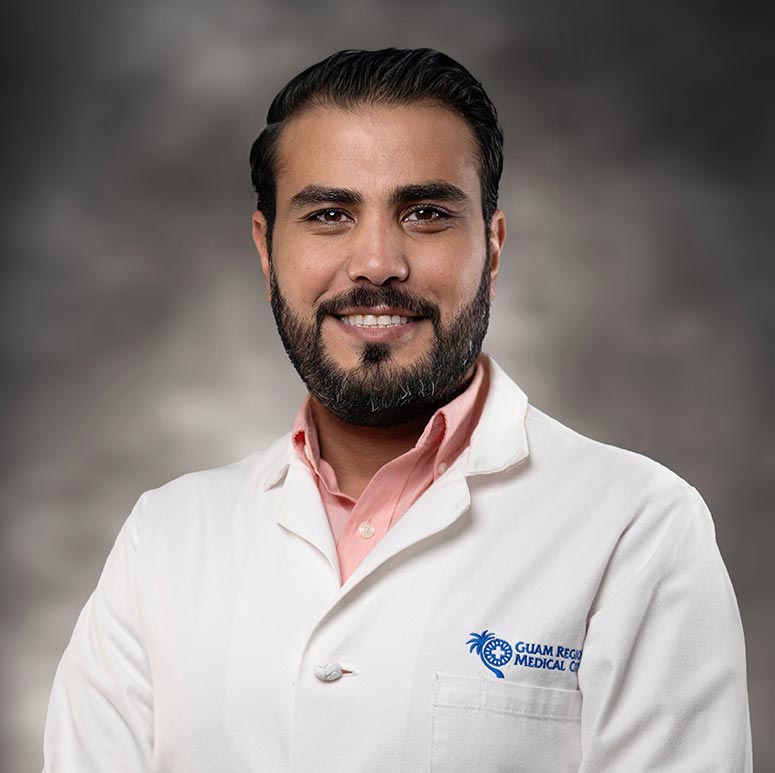 Our hospital offers specialized care services to address unique medical needs.
Our hospital offers specialized care services to address unique medical needs.  Our hospital offers specialized care services to address unique medical needs.
Our hospital offers specialized care services to address unique medical needs. 
GRMC is committed to reducing the incidence of heart disease which is the number one killer on Guam.
Our specialists work together to offer both treatment and preventive care for various cardiac conditions. We encourage minimally invasive procedures which enable patients to recover quickly and get back to living full, quality lives..
Prevention is also a key part of our approach. We support programs that encourage healthy life style choices. We emphasize the importance of exercise, diet and stress management. Special attention is given to high risk individuals including smokers, those with high blood pressure, and diabetes.
Conditions Treated:
Diagnostic tests and technologies available:
Echocardiography is a medical imaging technique that uses ultrasound waves to create real-time images of the heart. It provides detailed information about the structure and function of the heart, allowing healthcare professionals to assess its chambers, valves, and overall performance. Echocardiograms are commonly used to diagnose and monitor various cardiovascular conditions, such as heart valve disorders, heart failure, and congenital heart defects. This non-invasive and widely accessible procedure helps guide treatment decisions and assess cardiac health.
Stress testing is a method used in various fields to evaluate how a system, entity, or individual responds under adverse conditions. In finance, it assesses the resilience of financial institutions or portfolios during economic challenges. In software engineering, stress testing evaluates the stability and performance of computer systems or applications under extreme conditions.
In medicine, particularly cardiac stress testing, it assesses how well the heart responds to increased workload, aiding in the identification of potential heart-related issues. The primary goal of stress testing is to uncover vulnerabilities and weaknesses under challenging conditions, allowing for proactive measures to enhance overall resilience and performance.
Cardiac CT: Cardiac CT involves the use of X-rays to create detailed cross-sectional images of the heart and blood vessels. It is particularly effective in visualizing coronary arteries, identifying blockages, and assessing the overall anatomy of the heart. Cardiac CT can also provide valuable information about cardiac function, such as ejection fraction and chamber dimensions. It is commonly used for coronary artery disease evaluation, detection of congenital heart abnormalities, and preoperative planning.
Cardiac MRI: Cardiac MRI, on the other hand, utilizes a strong magnetic field and radio waves to generate detailed images of the heart. This imaging technique is excellent for assessing cardiac structure, function, and blood flow. Cardiac MRI is particularly valuable in evaluating myocardial infarctions (heart attacks), myocardial viability, and congenital heart diseases. It can also provide crucial information about cardiac tissue characteristics and help guide treatment decisions.
Both Cardiac CT and MRI play essential roles in cardiovascular imaging, providing non-invasive and detailed insights into the structure and function of the heart, aiding in the diagnosis and management of various cardiac conditions. The choice between these modalities depends on the specific clinical questions, patient factors, and the information needed by healthcare providers.
Pacemaker placement, also known as pacemaker implantation, is a medical procedure in which a small electronic device called a pacemaker is surgically implanted into a patient’s chest or abdomen. The pacemaker is typically used to regulate and control the heart’s rhythm. This procedure is often performed when the heart’s natural electrical system is not functioning properly, leading to issues like bradycardia (slow heart rate) or other rhythm disturbances.
During the pacemaker placement procedure, a small incision is made, and insulated wires (leads) are threaded through blood vessels into the heart. The leads are then connected to the pacemaker device, which is usually placed under the skin. The pacemaker continuously monitors the heart’s electrical activity and delivers electrical impulses as needed to regulate the heartbeat.
Pacemaker placement is a common and generally safe procedure, and it plays a crucial role in managing various cardiac conditions, ensuring that the heart maintains a stable and appropriate rhythm. Patients with pacemakers often experience improved quality of life and symptom relief.
Implantable Cardioverter-Defibrillator (ICD) Placement:
ICD placement is a medical procedure involving the implantation of an implantable cardioverter-defibrillator, a small device designed to monitor and regulate the heart’s rhythm. It is commonly used for individuals at risk of life-threatening arrhythmias or sudden cardiac arrest. The ICD continuously monitors the heart’s electrical activity and delivers electrical shocks to restore a normal rhythm if a dangerous arrhythmia is detected.
Biventricular Device Placement (Cardiac Resynchronization Therapy – CRT):
Biventricular device placement, also known as cardiac resynchronization therapy (CRT), involves implanting a specialized pacemaker with three leads. This procedure is typically performed in individuals with heart failure and a specific type of electrical conduction delay, known as left bundle branch block. The biventricular device helps synchronize the contractions of the heart’s ventricles, improving overall cardiac function and reducing heart failure symptoms.
Both ICD and biventricular device placements are essential interventions in the field of cardiology, aimed at managing and treating specific cardiac conditions, ultimately improving patients’ quality of life and reducing the risk of life-threatening events.
Electrophysiology testing is a medical procedure used to assess the electrical activity of the heart and diagnose or evaluate arrhythmias (abnormal heart rhythms). This test is typically performed by cardiac electrophysiologists, who are specialized cardiologists.
During an electrophysiology test, thin, flexible tubes called catheters are threaded through blood vessels, usually from the groin area, to the heart. These catheters contain electrodes that can record the electrical signals produced by the heart. The procedure is often done in a specialized cardiac catheterization laboratory.
The primary purposes of electrophysiology testing include:
Diagnosis of Arrhythmias: By recording and analyzing the heart’s electrical signals, healthcare professionals can identify the presence and type of arrhythmias, such as atrial fibrillation, atrial flutter, or ventricular tachycardia.
Mapping the Heart’s Electrical Pathways: The test helps create a map of the heart’s electrical pathways, pinpointing areas that may be causing abnormal rhythms.
Assessment of Conduction System Function: Electrophysiology testing allows for the evaluation of the heart’s conduction system, including the atrioventricular (AV) node and the bundle of His.
Guidance for Treatment: The information obtained from electrophysiology testing can guide the treatment of arrhythmias. In some cases, catheter ablation may be performed during the same procedure to correct or eliminate the abnormal electrical pathways causing the arrhythmia.
Cardiac ablation is a medical procedure used to treat certain types of abnormal heart rhythms, known as arrhythmias. During this procedure, a catheter (a thin, flexible tube) is threaded through blood vessels to the heart. The catheter delivers energy, such as radiofrequency or cryotherapy, to destroy or scar the tissue in the heart that is causing the irregular electrical signals responsible for the arrhythmia.
Key points about cardiac ablation include:
Types of Arrhythmias: Cardiac ablation is often used to treat supraventricular tachycardias (SVTs) and some types of ventricular arrhythmias. SVTs include conditions like atrial fibrillation, atrial flutter, and Wolff-Parkinson-White syndrome.
Catheter Ablation: During the procedure, one or more catheters are carefully positioned in the heart, guided by imaging techniques. The catheters have electrodes at their tips that can deliver heat (radiofrequency ablation) or extreme cold (cryoablation) to modify or destroy the abnormal tissue causing the arrhythmia.
Mapping the Heart: Prior to ablation, electrophysiology testing is often performed to map the heart’s electrical pathways and identify the precise location of the arrhythmia source.
Procedure Duration: The duration of the procedure can vary, and some patients may require more than one ablation session to achieve the desired results.
Effectiveness: Cardiac ablation is generally considered effective in treating certain arrhythmias, providing long-term relief for many patients. However, the success of the procedure depends on the type and location of the arrhythmia.
Risks and Benefits: While cardiac ablation is generally safe, it does carry some risks, such as bleeding, infection, or damage to nearby structures. The benefits, however, often outweigh the risks for individuals with debilitating arrhythmias.
Cardiac ablation is an important therapeutic option for managing specific arrhythmias, and it is often recommended when medications alone are insufficient in controlling symptoms or when a more definitive treatment is needed. The decision to undergo cardiac ablation is made on a case-by-case basis, taking into consideration the patient’s overall health and the specific characteristics of their arrhythmia.
Both the Holter monitor and event monitor are devices used in cardiology to monitor and record the heart’s electrical activity over an extended period. These monitoring tools are particularly useful in capturing irregular heart rhythms or symptoms that may not be present during a brief medical office visit.
Holter Monitor:
Event Monitor:
Both Holter monitors and event monitors are valuable tools in diagnosing and monitoring various cardiac conditions, especially those related to irregular heart rhythms. The choice between them depends on the frequency and nature of symptoms, helping healthcare professionals gather essential information to make accurate diagnoses and treatment decisions.
NOTICE: Guam Regional Medical City Announces Internship Opportunities: SHINE Bootcamp and SHInE M.D. Physician Track





